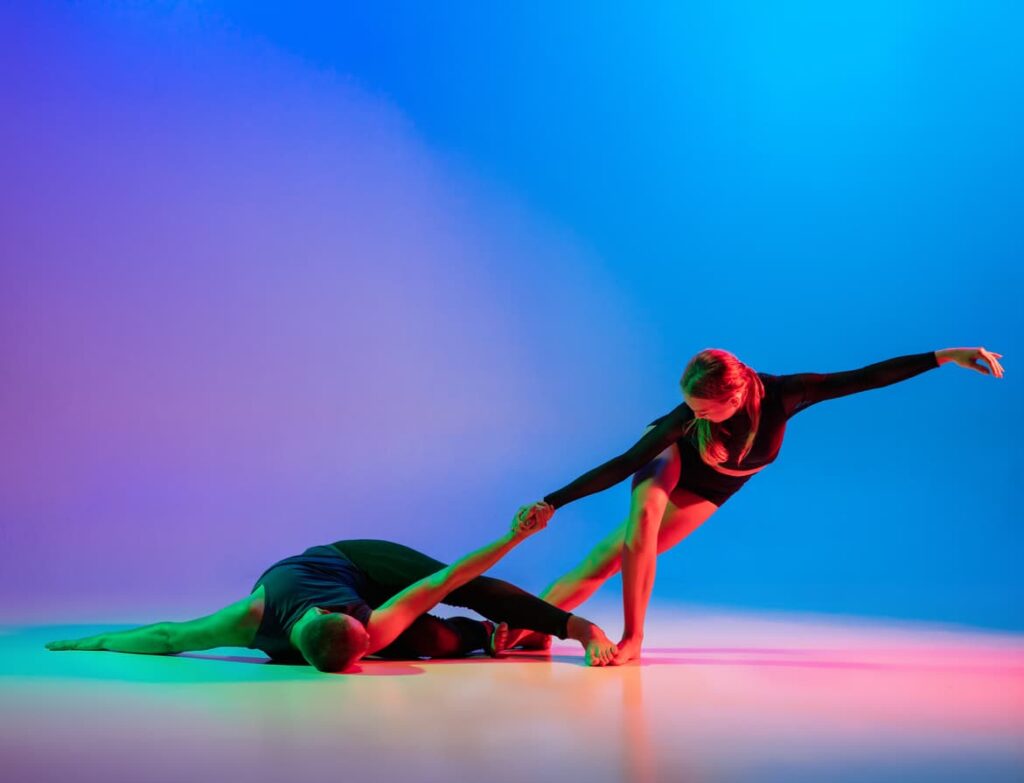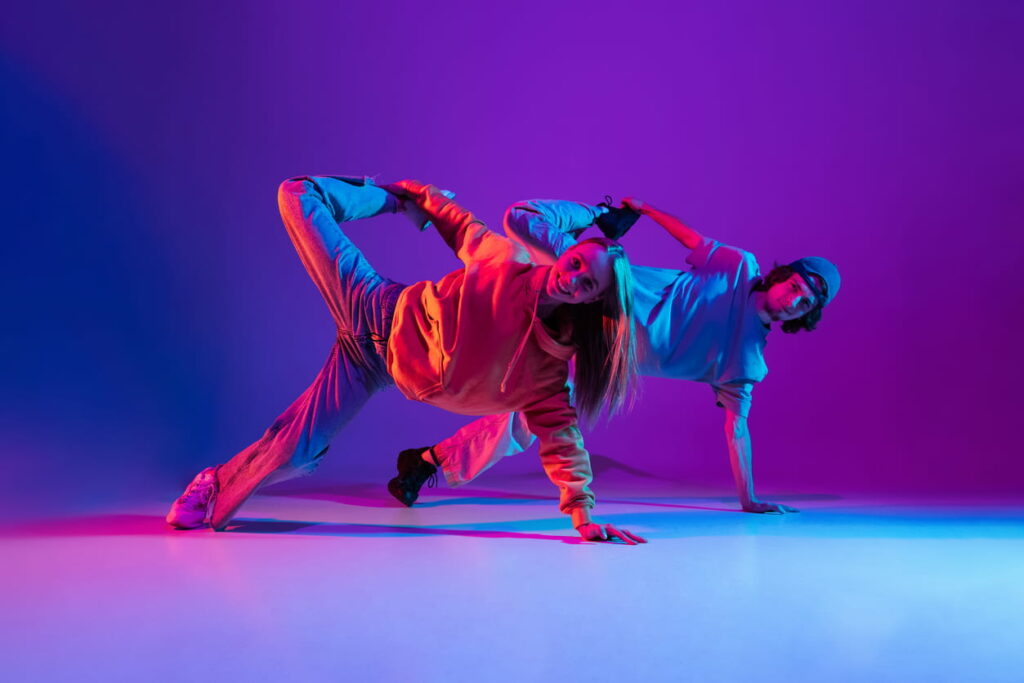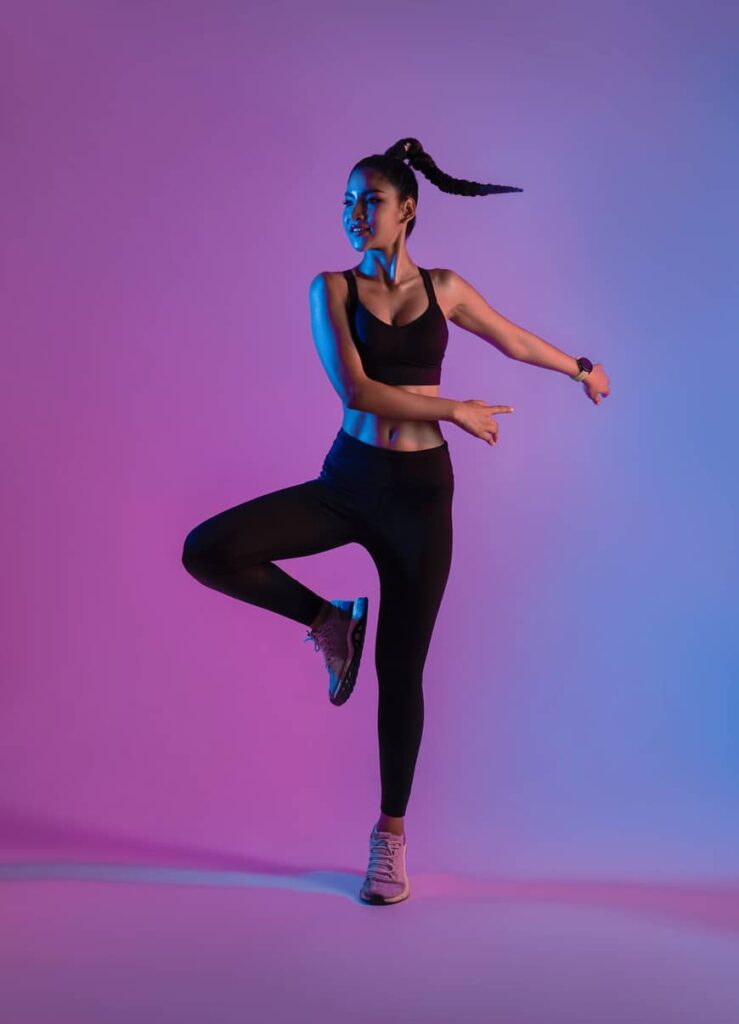
Summary
Welcome » Welcome » Virtues of dance » Dancing to build muscle: the areas stimulated
Dancing to build muscle: the areas stimulated
Summary
Dancing to build muscle: preparatory exercises
It is important to warm up before dancing to build muscle. On the one hand for your progress in dance. On the other hand, to improve your physical condition. Warm-ups are useful for all types of dances. These are precise exercises that will build muscle quickly without pain.
Strengthen your thighs
We know it when we dance, the most active limbs are the thighs. So, it is essential to warm up and pre-muscle your thighs in order to better strengthen them during dancing. Here are some exercises that will help you progress in this direction.
To strengthen your hamstring muscles, the simple and effective solution is squats. Feet shoulder-width apart, legs bent. Do 20 to 30 squats. The exercise is finished.
You can also do a unilateral standing hamstring stretch. It will allow you to strengthen this area and protect the kneecap so you can dance safely.
To perform this workout, place one leg 30cm in front of the other, your heels should be in a straight line. Then raise your tiptoes to straighten the back of your thighs. Lean forward, push back on your buttocks and lower your trunk as far as possible while keeping your back straight. Hold this position for 30 seconds, keeping your knees straight. Do the same for the other leg.
Strengthen your back
If you have back pain, it is probably due to a muscle deficit. That is why it is advisable to strengthen it so that your pain disappears. We give you some exercises that you can reproduce.
You can do a back core exercise to strengthen your paraspinal muscles, glutes and hamstrings.
How to practice back cladding? Get into a 4-legged position. Stretch one leg back and your opposite arm simultaneously. Your core, arm and leg should be aligned. To keep your back straight, contract your buttocks and stomach. Hold the position for 20 seconds then repeat this pose on the other leg. Do this operation 3 times.
Most often, back pain originates from the lower back. Here is the solution to your problem: Superman sheathing. It makes you work the paraspinal muscles, strengthens the lumbar area and the entire lower part of your back.
To put it into practice, you need a cushion. Lie on it and straighten your arms and legs. Lift your stomach and legs while contracting your glutes. Find balance in your arms, trunk and legs. Then, perform leg and arm kicks for 20 seconds then release. Repeat this exercise 3 times.
Strengthen your arms
To have muscular arms, there are exercises to put your arms in dancing condition. Here are our tips:
For the first exercise, you should be standing with your legs slightly apart. Get two dumbbells. Inhale then raise the weights to your shoulders, lower them, exhale.
The second exercise takes place on a chair. Sit down and place your hands under each buttock until your shoulder blades are together. Then stand up, go down with your elbows bent. Finally, come back up while exhaling. The exercise must be performed 30 times.
Toned body parts
As with any physical activity, certain parts of your body are active. In dance, this is also the case. You will tone and strengthen some of your muscles. Find below those that you put to the test as well as tips for knowing your body better.
The top of the body
Depending on the type of dance you practice, your upper body will be more or less engaged. This part includes the shoulders, arms and forearms. It is not with Bachata, salsa or any style of duo dance that you will have developed abs, for example. However, they will be at least muscular.
No matter the dance, the back and abdominal areas are always active since they allow the rotation of the trunk. For the most curious, the latter are composed of several muscle layers. Notably the rectus abdominis, the internal and external obliques and the transverse.
How to build abdominal muscles? It is thanks to the maintenance of postures, the alignment of the pelvis and the different dance steps which help to tone the abdominals. However, the forearms, arms and shoulders are spared. Indeed, dance in general does not seek to strengthen them, except in specific cases such as hip-hop or breakdance tricks which allow them to be strengthened.
Lower limbs
In dance, your lower body is constantly moving. This is why your legs are warm and stiff after each session, because they are working and the strengthening is working!
Among the lower limbs, it is the glutes which are used first. These are the gluteal muscles. We find the gluteus maximus, minor and medius. They are the most powerful and largest in the body. They are the ones that move first since they allow movement of the thigh and support of the pelvis.
We also find the quadriceps which are muscles at the front of the thigh. Inside there is the vastus femoris, THE vastus lateralis, THE vastus medialis, THE vast intermediate. They are heavily used since they mediate the flexion of the thighs on the hips and allow the extension of the legs on the thighs and participate in muscle strengthening. It is for these reasons that you have aches in your legs after a session.
Next, the hamstring muscles located at the back of the thigh have the same role as the quadriceps.
Finally, the calves are the last to work, they extend the foot on the leg.
Dancing, through its movements, steps, flexions and extensions, strengthens your lower muscles. They become more resilient, strong and powerful with the help of dance.
The benefits
Dance is a complete discipline that represents benefits both physical and mental.
Physical benefits
You suspect it, dancing is a very good ally to strengthen your muscles. Indeed, without you realizing it, with each movement you make, a muscle is in action. By repeating movements like in a choreography, you tone them up.
You increase your endurance. When you dance, your heart rate increases. The more you practice dancing, the more your cardio resists. You will be able to practice a physical activity for a long time without fatigue.
You strengthen your bones and preserve your joints. Additionally, dancing helps prevent osteoarthritis.
Flexibility and stretching exercises increase your flexibility. This is because as your muscles expand and stretch, you become more flexible. If you are interested in flexibility exercises, you can read our article Dance flexibility exercise: how to become more flexible to dance?
Finally, like swimming and cycling, regular dancing makes you lose weight. In 30 minutes of dancing, you burn between 200 and 400 calories.
The psychological benefits
Dance allows you to:
- Stimulate your creativity and sociability.
- It also allows you help get out of depression, of reduce your stress and anxiety and to do boost your self-esteem.
- Dancing strengthens your brain by developing your memorization and slows down its aging.
- Dancing is a great way toimprove your moods. We notice that she channels adrenaline, brings joy and motivation.
- This sport is good for your health in general since it gets you back in shape.
Everything you need to remember
Dancing to build muscle requires a lot of knowledge of the body. Let’s take a look at what this style of dance offers.
If you want to strengthen a particular area, you can. Indeed, we have given you some exercises to do to strengthen your back, thighs and arms. Of course, there are other exercises to strengthen other areas of the body!
Then, whatever type of dance you do, zumba, hip-hop or even classical dance, you operate 2 different groups of limbs: the upper limbs and the lower limbs. In the upper limbs, the shoulders and arms are the least stimulated compared to the abdomen and back. Concerning the lower limbs, it is your legs and your glutes that work the most.
Your work will bear fruit since you will obtain physical and mental benefits.
Physically, you strengthen and tone your muscles. You improve your endurance, preserve your joints, increase your flexibility and lose weight.
Psychologically, dancing will allow you to express your creativity and socialize more. It also helps ward off depression, anxiety and stress. You will regain confidence in yourself. You will improve your memory which will slow down the aging of your brain. You will have better moods, joy of life, motivation and dancing keeps you in shape.
Try dancing at DECIBEL®
Are you motivated to warm up your muscles while dancing? Discover dance differently at DECIBEL®.
Shake your hips for 50 minute sessions. Build muscle with the mixture of workout and of dance and your body will thank you.
Want to free yourself by dancing?
Read also
follow us
on instagram
Follow our news,
take advantage of our tutorials and participate to our
contests!
BREAKING NEWS!
Receive our newsletter.








